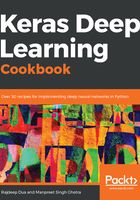
上QQ阅读APP看书,第一时间看更新
How to do it...
Let's load this dataset using the Keras APIs and print the shape and size:
from keras.datasets import cifar10
(X_train, y_train), (X_test, y_test) = cifar10.load_data()
print("X_train shape: " + str(X_train.shape))
print(y_train.shape)
print(X_test.shape)
print(y_test.shape)
The first time, it will download the file from the preceding site:
Downloading data from https://www.cs.toronto.edu/~kriz/cifar-10-python.tar.gz
8192/170498071 [..............................] - ETA: 22:43
40960/170498071 [..............................] - ETA: 9:12
106496/170498071 [..............................] - ETA: 5:27
237568/170498071 [..............................] - ETA: 3:11
286720/170498071 [..............................] - ETA: 4:39
...
170418176/170498071 [============================>.] - ETA: 0s
170467328/170498071 [============================>.] - ETA: 0s
170500096/170498071 [==============================] - 308s 2us/step
The following output shows X_train has 50,000 images of size 32 x 32 containing three channels. y_train has 50,000 rows and one column with the image label. X_test and y_test also have a similar shape for 10,000 rows:
X_train shape: (50000, 32, 32, 3)
y_train shape: (50000, 1)
X_test shape: (10000, 32, 32, 3)
y_test shape: (10000, 1)
In the next recipe, we look at how to load the CIFAR-100 dataset.